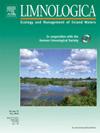富氮试验中,水生菌丝菌表现出污染诱导的群落耐受性
IF 2
4区 环境科学与生态学
Q2 LIMNOLOGY
引用次数: 0
摘要
淡水生态系统在世界范围内面临重大威胁,特别是来自影响生物多样性和河流和溪流生态系统功能的土地利用变化。碳、氮、磷等基本元素通过直接影响微生物活动和有机物加工,在这些生态系统中起着至关重要的作用。本研究探讨了阿根廷Córdoba Chocancharava河中氮含量增加对与分解凋落叶相关的水生菌丝菌多样性和繁殖的影响。通过微观环境试验,确定了柳树的定植真菌种类,分析了真菌群落的结构变量,并评估了柳树的产孢率和凋落叶分解率的变化。与预期相反,对照和富营养化处理之间的真菌群落结构没有显著差异。氮浓度的增加并没有促进真菌群落的生长,这表明真菌对化学胁迫的适应可能与污染诱导的群落耐受性的概念一致。这些发现为水生生态系统对养分富集的恢复力提供了有价值的见解,强调了了解微生物反应对有效生态系统管理的重要性。本文章由计算机程序翻译,如有差异,请以英文原文为准。
Aquatic hyphomycetes show pollution-induced community tolerance in nitrogen enrichment experiment
Freshwater ecosystems face significant threats worldwide, particularly from land use changes that impact biodiversity and ecosystem functions in rivers and streams. Essential elements such as carbon, nitrogen, and phosphorus play crucial roles in these ecosystems by directly influencing microbial activity and organic matter processing. This study examines the impact of increased nitrogen levels on the diversity and reproduction of aquatic hyphomycetes associated with decomposing leaf litter in the Chocancharava River, Córdoba, Argentina. Through a microcosm experiment, the objectives were to identify colonizing fungal species, analyze structural variables of the fungal community, and assess variations in sporulation rates and leaf litter decomposition rates of Salix sp. Contrary to expectations, no significant differences in fungal community structure were observed between the control and nutrient-enriched treatments. The increased nitrogen concentrations did not enhance fungal community growth, suggesting possible adaptation to chemical stressors consistent with the concept of pollution-induced community tolerance. These findings provide valuable insights into aquatic ecosystem resilience to nutrient enrichment, highlighting the importance of understanding microbial responses for effective ecosystem management.
求助全文
通过发布文献求助,成功后即可免费获取论文全文。
去求助
来源期刊

Limnologica
环境科学-湖沼学
CiteScore
3.70
自引率
5.90%
发文量
64
审稿时长
3 months
期刊介绍:
Limnologica is a primary journal for limnologists, aquatic ecologists, freshwater biologists, restoration ecologists and ecotoxicologists working with freshwater habitats.
 求助内容:
求助内容: 应助结果提醒方式:
应助结果提醒方式:


